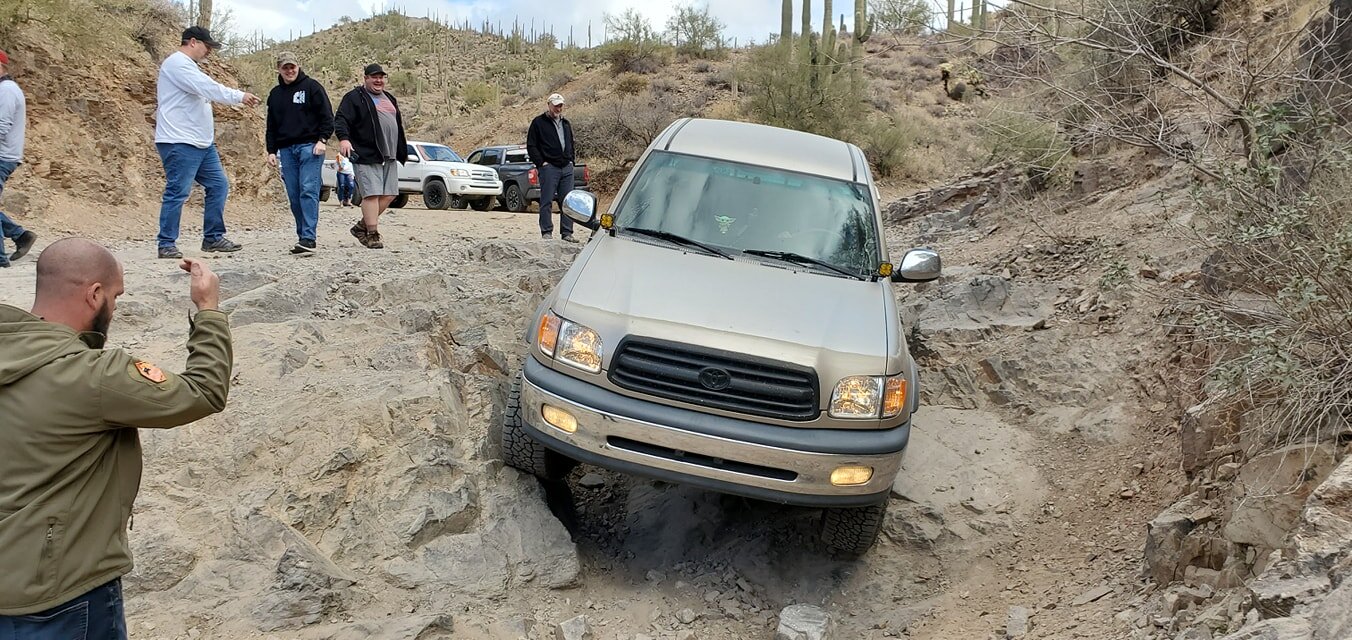
So you are thinking of
buying a 2000-2006 Toyota Tundra?
Most likely, it’s got some age on it. Some miles too. Don’t worry, we’re going to walk you through what needs to be checked out, what questions need to be asked, and what the common failure points are you need to take care of.
Example of Frame and Body Rust
#1 - Is there a rust issue?
The very first thing you should check is the frame of the truck to see how bad, if at all, the rust damage is. It is very common to find frames that spent years in areas where they salt the roads in the winter close to disintegrating, and while there is a recall that may get you a new frame, those are becoming rarer and rarer as time goes by. No matter where you are buying your truck, take a few minutes and look at the frame underneath; some southern trucks sat beside salty beaches their entire lives and some New York trucks sat in a garage all winter, so there’s no hard and fast rule on “safe” places to buy trucks from.
Lower ball joint failure
#2 - Have the high-mileage maintenance items been addressed?
Besides the normal maintenance items of fluid changes, spark plugs, bushings, tires, etc, there are several maintenance items that, if ignored, can cause catastrophic problems with your truck.
First, timing belt changes should be done approximately 100,000 miles or 10 years, whichever comes first. If there’s not a timing belt change sticker on the air intake, or a record of one being completed, you may want to remove a cover and check out the wear of the one on the truck. If needing to be done, you may as well swap the water pump and other wear items while you’re in there. We have the timing belt rebuild kits listed under our Common Maintenance Parts. The reason this is important, especially with Tundras with VVTI (variable-valve timing with intelligence), is that they are interference engines and a broken timing belt has a pretty good risk of destroying your engine.
Second, Lower Ball Joints (LBJ, no, not the president) are a bit of an infamous failure point on these trucks. Also a replacement item every 100,000 miles, failure to replace them can lead to catastrophic failure of the front control arm assemblies, wrecking fenders, spindles, etc. It’s also highly recommended you only use official OEM Toyota LBJs, as Moog and other brands have shown failure rates as soon as 20,000 miles with zero warning.
Third, radiator. As the stock Denso radiator is partially plastic, over time it can degrade and break down. While nobody likes a busted radiator, the real danger is an internal rupture where coolant goes into the transmission line that runs through the bottom of the radiator; the “pink milkshake” as it’s often called due to the pink Toyota coolant mixing with red transmission fluid, can quickly burn up a transmission and make a minor repair into a major expense. The general rule is if the plastic is a light brown color, it’s time to replace it. Many people also replace it at the same time as their timing belt as it’s easiest to remove at that point anyway.
Fourth, during the test drive check and see if the steering feels tight and responsive. If not, you may need new steering rack bushings. Odd thumps when accelerating or deaccelerating? Check the carrier bearing on the driveshaft for play.
The cost of these repairs varies, but should be calculated into your total purchase cost when looking at trucks.
#3 - Have any aftermarket parts been installed or added?
Depending on what parts were installed, it may have caused premature wear on certain items or create new headaches for you down the road.
For example, that 3” lift kit the owner mentioned in the sales ad may look great, but if he did not add in after market control arms or install a higher quality CV Axle boot, it may have worn out some things prematurely. Is that lift kit a spacer lift, or a true suspension lift? It makes a big difference in ride quality and how happy you will be long term driving your truck.
If it’s an earlier year of truck, have the brakes been upgraded to the larger 13WL brakes? Better to know that now, than to order parts that don’t fit your truck later on.
#4 - How was the truck originally optioned? Are there any open recalls?
Just because there’s a TRD sticker on the bed, doesn’t mean this truck really was a TRD. Get the VIN# and enter it at the Toyota Owners site to see how the truck was optioned when originally sold. It’s better to find out now that it’s not actually a TRD than after you buy it.
While there, also check and see if there are any open recalls on your truck that need to be addressed. In some cases, ball joints, frames, and other components have a recall open that you can take to any dealer to be addressed / inspected.
#5 - Is the truck worth the price?
Prices on trucks vary by region and options, mileage and condition so there’s no hard and fast rules for what is “fair”. For example, I bought my 2000 4WD Access Cab Tundra in 2015 for $7000. I thought that price was a bit high, but it was in good condition from someone I knew took care of it and had a relatively low 145,000 miles. Fast forward to 2021, and it’s not unusual to see that same truck, with 250,000+ miles selling for $8,000+. You will need to compare pricing on as many trucks in your area as possible to try and establish the going rate.


